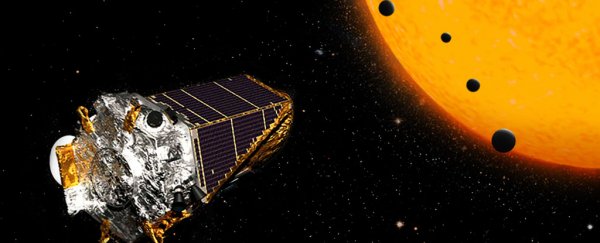An international team of scientists using NASA's Kepler telescope just announced a huge haul of more than 100 new exoplanets.
Among them is a four-planet solar system some 181 light-years away, which scientists say has a good chance of supporting life.
K2–72 is an M dwarf star orbited by four planets, lying in the direction of the Aquarius constellation.
Researchers suggest all four of these worlds could be rocky, and while they orbit their host star very closely, K2–72's relative coolness means two of them might be habitable.
While all of the planets around K2–72 are considered small as far as planets go, they're each between 20 to 50 percent larger than Earth is by diameter.
All four stick very close to K2–72 – closer than Mercury is to our Sun – but because K2–72 is a red dwarf, it's comparatively small and dim, and its habitable zone doesn't reach out as far as our Sun's as a result.
Because of this, two of K2–72's planets fall within the life-friendly boundary, with irradiation levels from their star comparable to those found on Earth, and offering conditions that would support the existence of liquid water on their surfaces.
The K2–72 discovery is just one gem among a massive haul of new exoplanets discovered by a team of researchers led by the University of Arizona's Lunar and Planetary Laboratory, who used Kepler to find 197 planet candidates, of which 104 are confirmed exoplanets – the biggest swathe of exoplanets found since Kepler's mind-boggling detection of 1,284 alien worlds just a couple of months back.
What's most remarkable about the latest discoveries is that these exoplanet identifications are actually the results of a total accident. In 2012 the space observatory's reaction wheels began to malfunction, robbing the telescope of the ability to stabilise itself towards a particular, narrow portion of the sky in its original mission.
Luckily NASA engineers struck upon an ingenious fix for the problem, calculating that photons from the Sun would be able to help stabilise the telescope for its new K2 mission, observing a broader portion of the sky within the ecliptic plane, and giving it greater scope to detect stars, including cooler, red-dwarf types like K2–72.
"An analogy would be to say that Kepler [originally] performed a demographic study, while the K2 mission focuses on the bright and nearby stars with different types of planets," said astronomer Ian Crossfield from the University of Arizona. "The K2 mission allows us to increase the number of small, red stars by a factor of 20, significantly increasing the number of astronomical 'movie stars' that make the best systems for further study."
The new mission also means we're finding out more about the most common kind of stars in the Milky Way, which will give us a greater understanding of the kinds of exoplanetary systems most frequently found throughout the galaxy.
"Kepler showed strong signs that there are plenty of planets, especially smallish planets around these smaller, cooler, so-called red dwarf stars," Crossfield told Amina Khan at the Los Angeles Times. "That's very exciting because these cool red dwarf stars dramatically outnumber stars like the sun."
With Kepler having laid the groundwork, astronomers are now eager to study these alien worlds further using other ground and space telescopes, with the hope that new observations will dig up more on what these planets are made up of – and possibly reveal whether they're actually capable of hosting life.
"This bountiful list of validated exoplanets from the K2 mission highlights the fact that the targeted examination of bright stars and nearby stars along the ecliptic is providing many interesting new planets," said K2 project scientist Steve Howell from NASA's Ames Research Centre in Moffett Field, California.
"These targets allow the astronomical community ease of follow-up and characterisation, providing a few gems for first study by the James Webb Space Telescope, which could perhaps tell us about the planets' atmospheres."
The findings are reported in the Astrophysical Journal Supplement Series.
